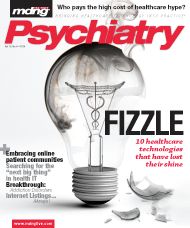Tech Talk: Patients are Doing it for Themselves
Many of our patients are using the Internet to look up their diagnoses and medications as soon as they get home from our offices.
Last month’s Health 2.0 issue got me thinking about the concept of communities on the Web. Many of our patients are using the Internet to look up their diagnoses and medications as soon as they get home from our offices. (Although they may be uncomfortable admitting this to us, thinking this implies they are second-guessing us and seeking medical information “behind our backs.”) Unfortunately, with the amount of biased and non-evidence-based medical information available online, our patients run the real risk of getting bad information. This is especially true if they frequent the myriad bulletin boards and online communities surrounding nearly every conceivable disease state.
There are two primary ways that patients get healthcare information from the Web. The first is by reading articles written by doctors, healthcare workers, journalists, and anyone else who can get published. When you type “diabetes” into Google, the first page results include the Center for Disease Control, WebMD, the American Diabetes Association, Wikipedia, and other sources of information from well-established mainstream sources. But further down the list are links to bulletin boards and forums. If you type “diabetes community” into Google, the first listings include support networks and communities of people who have diabetes or who know someone with diabetes. These communities allow people to share information with one another on a peer-to-peer level, frequently without the guidance or influence of a healthcare professional. Bulletin boards let people write a question or make a comment and then “post” the message so it can be read by anyone. Messages are organized into “threads” that read much like a conversation—but instead of two people talking there can be an unlimited number of participants sharing their advice and opinions.
It wasn’t always like this. A few years ago, a patient diagnosed with type II diabetes would have simply accepted the information you provided. Maybe they would have gone to a bookstore or library, or shared information if they happened to know someone else with the same condition. Today, most patients will go to their computer as soon as they leave your office. They will read whatever they can and then start interacting with others who share a similar interest. Most doctors don’t realize the extent to which patients use the Internet to learn from and converse with other nonhealthcare professionals.
Back in the 1990s, I co-created a website that focused on medical issues people were too embarrassed or uncomfortable discussing with their physician (aptly named www.afraidtoask.com). We added a bulletin board to the site, and over the past fi ve years, people have posted hundreds of thousands of messages. The most popular topic, male genitalia, currently has more than 36,000 messages organized into more than 4,000 discussion threads. There are also discussions on a host of other topics, including Lyme disease, breast cancer, masturbation, bowel movements, and more.
It is fascinating to read messages from the board. Some are touching, others repulsive; most are somewhere in-between, providing information and personal experiences of the writers. Some contain good medical information; others spread myths and misconceptions, usually corrected by other concerned posters. Patients need to be forewarned that bulletin boards can, and frequently do, contain erroneous information. A wise approach is to assume your patients will be looking at these sites and let them know you support them, but advise that they should consult with you before taking any kind of action, or if they have concerns or fears generated by the information they find.
Despite the pitfalls and potential false information, Web communities should be celebrated because on balance they do much more good than harm. People can gain valuable information from peers that we don’t always have the time to give them during an office visit. They also get to commiserate and empathize with people who share similar experiences. Because people can maintain their anonymity, they are also more willing to open up and share things they would never tell their doctor, parents, or spouse. This is powerful stuff, and it allows for some amazing interactions that would rarely occur in the brick-and-mortar world of medical offices and hospitals.
Dr. Bertman is Physician Editor-in-Chief of MDNG: Primary Care/Cardiology Edition. He is also a Clinical Assistant Professor of Family Medicine at Brown University and president of AmazingCharts.com, a leading developer of electronic health record (EHR) software. He also is the founder and president of AfraidToAsk.com, a consumer website focusing on personal medical topics. He is in private practice in Hope Valley, RI.
